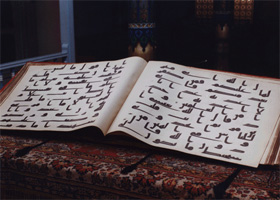After Muhammad had preached publicly for more than a decade, the opposition to him reached such a high pitch that, fearful for their safety, he sent some of his adherents to Ethiopia. There, the Christian ruler extended protection to them, the memory of which has been cherished by Muslims ever since. But in Mecca the persecution worsened. Muhammad’s followers were harassed, abused, and even tortured. At last, seventy of Muhammad’s followers set off by his orders to the northern town of Yathrib, in the hope of establishing a news stage of the Islamic movement. This city which was later to be renamed Medina (“The City”). Later, in the early fall of 622, he, with his closest friend, Abu Bakr al-Siddeeq, set off to join the emigrants. This event coincided with the leaders in Mecca plotting, to kill him.
In Mecca, the plotters arrived at Muhammad’s home to find that his cousin, ‘Ali, had taken his place in bed. Enraged, the Meccans set a price on Muhammad’s head and set off in pursuit. Muhammad and Abu Bakr, however, had taken refuge in a cave, where they hid from their pursuers. By the protection of God, the Meccans passed by the cave without noticing it, and Muhammad and Abu Bakr proceeded to Medina. There, they were joyously welcomed by a throng of Medinans, as well as the Meccans who had gone ahead to prepare the way.
This was the Hijrah - anglicized as Hegira - usually, but inaccurately, translated as “Flight” - from which the Muslim era is dated. In fact, the Hijrah was not a flight, but a carefully planned migration that marks not only a break in history - the beginning of the Islamic era - but also, for Muhammad and the Muslims, a new way of life. Henceforth, the organizational principle of the community was not to be mere blood kinship, but the greater brotherhood of all Muslims. The men who accompanied Muhammad on the Hijrah were called the Muhajiroon - “those that made the Hijrah” or the “Emigrants” - while those in Medina who became Muslims were called the Ansar, or “Helpers.”
Muhammad was well acquainted with the situation in Medina. Earlier, before the Hijrah, various of its inhabitants came to Mecca to offer the annual pilgrimage, and as the Prophet would take this opportunity to call visiting pilgrims to Islam, the group who came from Medina heard his call and accepted Islam.. They also invited Muhammad to settle in Medina. After the Hijrah, Muhammad’s exceptional qualities so impressed the Medinans that the rival tribes and their allies temporarily closed ranks as, on March 15, 624, Muhammad and his supporters moved against the pagans of Mecca.
The first battle, which took place near Badr, now a small town southwest of Medina, had several important effects. In the first place, the Muslim forces, outnumbered three to one, routed the Meccans. Secondly, the discipline displayed by the Muslims brought home to the Meccans, perhaps for the first time, the abilities of the man they had driven from their city. Thirdly, one of the allied tribes which had pledged support to the Muslims in the Battle of Badr, but had then proved lukewarm when the fighting started, was expelled from Medina one month after the battle. Those who claimed to be allies of the Muslims, but tacitly opposed them, were thus served warning: membership in the community imposed the obligation of total support.
A year later the Meccans struck back. Assembling an army of three thousand men, they met the Muslims at Uhud, a ridge outside Medina. After initial successes, the Muslims were driven back and the Prophet himself was wounded. As the Muslims were not completely defeated, the Meccans, with an army of ten thousand, attacked Medina again two years later but with quite different results. At the Battle of the Trench, also known as the Battle of the Confederates, the Muslims scored a signal victory by introducing a new form of defense. On the side of Medina from which attack was expected, they dug a trench too deep for the Meccan cavalry to clear without exposing itself to the archers posted behind earthworks on the Medina side. After an inconclusive siege, the Meccans were forced to retire. Thereafter Medina was entirely in the hands of the Muslims.
The Constitution of Medina - under which the clans accepting Muhammad as the Prophet of God formed an alliance, or federation - dates from this period. It showed that the political consciousness of the Muslim community had reached an important point; its members defined themselves as a community separate from all others. The Constitution also defined the role of non-Muslims in the community. Jews, for example, were part of the community; they were dhimmis, that is, protected people, as long as they conformed to its laws. This established a precedent for the treatment of subject peoples during the later conquests. Christians and Jews, upon payment of a nominal tax, were allowed religious freedom and, while maintaining their status as non-Muslims, were associate members of the Muslim state. This status did not apply to polytheists, who could not be tolerated within a community that worshipped the One God.
Ibn Ishaq, one of the earliest biographers of the Prophet, says it was at about this time that Muhammad sent letters to the rulers of the earth - the King of Persia, the Emperor of Byzantium, the Negus of Abyssinia, and the Governor of Egypt among others - inviting them to submit to Islam. Nothing more fully illustrates the confidence of the small community, as its military power, despite the battle of the Trench, was still negligible. But its confidence was not misplaced. Muhammad so effectively built up a series of alliances among the tribes that, by 628, he and fifteen hundred followers were able to demand access to the Kaaba. This was a milestone in the history of the Muslims. Just a short time before, Muhammad left the city of his birth to establish an Islamic state in Medina. Now he was being treated by his former enemies as a leader in his own right. A year later, in 629, he reentered and, in effect, conquered Mecca, without bloodshed and in a spirit of tolerance, which established an ideal for future conquests. He also destroyed the idols in the Kaabah, to put an end forever to pagan practices there. At the same time ‘Amr ibn al-’As, the future conqueror of Egypt, and Khalid ibn al-Walid, the future “Sword of God,” accepted Islam, and swore allegiance to Muhammad. Their conversion was especially noteworthy because these men had been among Muhammad’s bitterest opponents only a short time before.
In one sense Muhammad’s return to Mecca was the climax of his mission. In 632, just three years later, he was suddenly taken ill and on June 8 of that year, with his third wife Aisha in attendance, the Messenger of God “died with the heat of noon.”
The death of Muhammad was a profound loss. To his followers this simple man from Mecca was far more than a beloved friend, far more than a gifted administrator, far more than the revered leader who had forged a new state from clusters of warring tribes. Muhammad was also the exemplar of the teachings he had brought them from God: the teachings of the Quran, which, for centuries, have guided the thought and action, the faith and conduct, of innumerable men and women, and which ushered in a distinctive era in the history of mankind. His death, nevertheless, had little effect on the dynamic society he had created in Arabia, and no effect at all on his central mission: to transmit the Quran to the world. As Abu Bakr put it: “Whoever worshipped Muhammad, let him know that Muhammad is dead, but whoever worshipped God, let him know that God lives and dies not.”
With the death of Muhammad, the Muslim community was faced with the problem of succession. Who would be its leader? There were four persons obviously marked for leadership: Abu Bakr al-Siddeeq, who had not only accompanied Muhammad to Medina ten years before, but had been appointed to take the place of the Prophet as leader of public prayer during Muhammad’s last illness; Umar ibn al-Khattab, an able and trusted Companion of the Prophet; Uthman ibn ‘Affan, a respected early convert; and ‘Ali ibn Abi Talib, Muhammad’s cousin and son-in-law. There piousness and ability to govern the affairs of the Islamic nation was uniformly par excellence. At a meeting held to decide the new leadership, Umar grasped Abu Bakr’s hand and gave his allegiance to him, the traditional sign of recognition of a new leader. By dusk, everyone concurred, and Abu Bakr had been recognized as the khaleefah of Muhammad. Khaleefah - anglicized as caliph - is a word meaning “successor”, but also suggesting what his historical role would be: to govern according to the Quran and the practice of the Prophet.
Abu Bakr’s caliphate was short, but important. An exemplary leader, he lived simply, assiduously fulfilled his religious obligations, and was accessible and sympathetic to his people. But he also stood firm when some tribes, who had only nominally accepted Islam, renounced it in the wake of the Prophet’s death. In what was a major accomplishment, Abu Bakr swiftly disciplined them. Later, he consolidated the support of the tribes within the Arabian Peninsula and subsequently funneled their energies against the powerful empires of the East: the Sassanians in Persia and the Byzantines in Syria, Palestine, and Egypt. In short, he demonstrated the viability of the Muslim state.
The second caliph, Umar - appointed by Abu Bakr - continued to demonstrate that viability. Adopting the title Ameer al-Mumineen, or Commander of the Believers, Umar extended Islam’s temporal rule over Syria, Egypt, Iraq, and Persia in what, from a purely military standpoint, were astonishing victories. Within four years after the death of the Prophet, the Muslim state had extended its sway over all of Syria and had, at a famous battle fought during a sandstorm near the River Yarmuk, blunted the power of the Byzantines - whose ruler, Heraclius, had shortly before refused the call to accept Islam.
Even more astonishingly, the Muslim state administered the conquered territories with a tolerance almost unheard of in that age. At Damascus, for example, the Muslim leader, Khalid ibn al-Walid, signed a treaty which read as follows:
This is what Khalid ibn al-Walid would grant to the inhabitants of Damascus if he enters therein: he promises to give them security for their lives, property and churches. Their city wall shall not be demolished; neither shall any Muslim be quartered in their houses. Thereunto we give them the pact of God and the protection of His Prophet, the caliphs and the believers. So long as they pay the poll tax, nothing but good shall befall them.
This tolerance was typical of Islam. A year after Yarmook, Umar, in the military camp of al-Jabiyah on the Golan Heights, received word that the Byzantines were ready to surrender Jerusalem. Consequently, he rode there to accept the surrender in person. According to one account, he entered the city alone and clad in a simple cloak, astounding a populace accustomed to the sumptuous garb and court ceremonials of the Byzantines and Persians. He astounded them still further when he set their fears at rest by negotiating a generous treaty in which he told them: “In the name of God ... you have complete security for your churches, which shall not be occupied by the Muslims or destroyed.”
This policy was to prove successful everywhere. In Syria, for example, many Christians who had been involved in bitter theological disputes with Byzantine authorities - and persecuted for it - welcomed the coming of Islam as an end to tyranny. And in Egypt, which Amr ibn al-As took from the Byzantines after a daring march across the Sinai Peninsula, the Coptic Christians not only welcomed the Arabs, but enthusiastically assisted them.
This pattern was repeated throughout the Byzantine Empire. Conflict among Greek Orthodox, Syrian Monophysites, Copts, and Nestorian Christians contributed to the failure of the Byzantines - always regarded as intruders - to develop popular support, while the tolerance which Muslims showed toward Christians and Jews removed the primary cause for opposing them.
Umar adopted this attitude in administrative matters as well. Although he assigned Muslim governors to the new provinces, existing Byzantine and Persian administrations were retained wherever possible. For fifty years, in fact, Greek remained the chancery language of Syria, Egypt, and Palestine, while Pahlavi, the chancery language of the Sassanians, continued to be used in Mesopotamia and Persia.
Umar, who served as caliph for ten years, ended his rule with a significant victory over the Persian Empire. The struggle with the Sassanid realm had opened in 636 at al-Qadisiyah, near Ctesiphon in Iraq, where Muslim cavalry had successfully coped with elephants used by the Persians as a kind of primitive tank. Now with the Battle of Nihavand, called the “Conquest of Conquests,” Umar sealed the fate of Persia; henceforth it was to be one of the most important provinces in the Muslim Empire.
His caliphate was a high point in early Islamic history. He was noted for his justice, social ideals, administration, and statesmanship. His innovations left an all enduring imprint on social welfare, taxation, and the financial and administrative fabric of the growing
empire
Election of Uthman

Umar ibn Al-Khattab, the second caliph of Islam, was stabbed by a Persian slave Abu Lu’lu’ah, a Persian Magian, while leading the Fajr Prayer. As Umar was lying on his death bed, the people around him asked him to appoint a successor. Umar appointed a committee of six people to choose the next caliph from among themselves.
This committee comprised Ali ibn Abi Talib, Uthman ibn Affan, Abdur-Rahman ibn Awf, Sad ibn Abi Waqqas, Az-Zubayr ibn Al-Awam, and Talhah ibn Ubayd Allah, who were among the most eminent Companions of the Prophet, may God send His praises upon him, and who had received in their lifetime the tidings of Paradise.
The instructions of Umar were that the Election Committee should choose the successor within three days, and he should assume office on the fourth day. As two days passed by without a decision, the members felt anxious that the time was running out fast, and still no solution to the problem appeared to be in sight. Abdur-Rahman ibn Awf offered to forgo his own claim if others agreed to abide by his decision. All agreed to let Abdur-Rahman choose the new caliph. He interviewed each nominee and went about Medinah asking the people for their choice. He finally selected Uthman as the new caliph, as the majority of the people chose him.
His Life as a Caliph
Uthman led a simple life even after becoming the leader of the Islamic state. It would have been easy for a successful businessman such as him to lead a luxurious life, but he never aimed at leading such in this world. His only aim was to taste the pleasure of the hereafter, as he knew that this world is a test and temporary. Uthman’s generosity continued after he became caliph.
The caliphs were paid for their services from the treasury, but Uthman never took any salary for his service to Islam. Not only this, he also developed a custom to free slaves every Friday, look after widows and orphans, and give unlimited charity. His patience and endurance were among the characteristics that made him a successful leader.
Uthman achieved much during his reign. He pushed forward with the pacification of Persia, continued to defend the Muslim state against the Byzantines, added what is now Libya to the empire, and subjugated most of Armenia. Uthman also, through his cousin Mu'awiyah ibn Abi Sufyan, the governor of Syria, established an Arab navy which fought a series of important engagements with the Byzantines.
Of much greater importance to Islam, however, was Uthman's compilation of the text of the Quran as revealed to the Prophet. Realizing that the original message from God might be inadvertently distorted by textual variants, he appointed a committee to collect the canonical verses and destroy the variant recensions. The result was the text that is accepted to this day throughout the Muslim world.
Opposition and the End
During his caliphate, Uthman faced much of hostility from new, nominal Muslims in newly Islamic lands, who started to accuse him of not following the example Prophet and the preceding caliphs in matters concerning governance . However, the Companions of the Prophet always defended him. These accusations never changed him. He remained persistent to be a merciful governor. Even during the time when his foes attacked him, he did not use the treasury funds to shield his house or himself. As envisaged by Prophet Muhammad, Uthman’s enemies relentlessly made his governing difficult by constantly opposing and accusing him. His opponents finally plotted against him, surrounded his house, and encouraged people to kill him.
Many of his advisors asked him to stop the assault but he did not, until he was killed while reciting the Quran exactly as the Prophet had predicted. Uthman died as a martyr.
Anas ibn Malik narrated the following:
“The Prophet once climbed the mountain of Uhud with Abu Bakr, Umar, and Uthman. The mountain shook with them. The Prophet said (to the mountain), ‘Be firm, O Uhud! For on you there is a Prophet, an early truthful supporter of mine, and two martyrs.’” (Saheeh al-Bukhari)
 Umar ibn Al-Khattab, the second caliph of Islam, was stabbed by a Persian slave Abu Lu’lu’ah, a Persian Magian, while leading the Fajr Prayer. As Umar was lying on his death bed, the people around him asked him to appoint a successor. Umar appointed a committee of six people to choose the next caliph from among themselves.
Umar ibn Al-Khattab, the second caliph of Islam, was stabbed by a Persian slave Abu Lu’lu’ah, a Persian Magian, while leading the Fajr Prayer. As Umar was lying on his death bed, the people around him asked him to appoint a successor. Umar appointed a committee of six people to choose the next caliph from among themselves.



